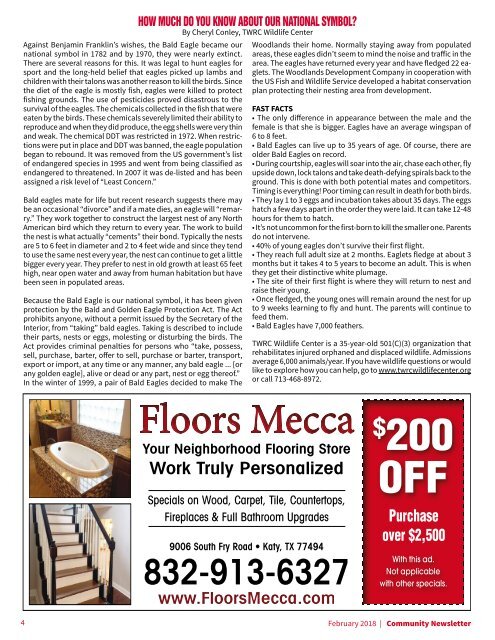Westfield Community February 2018
Create successful ePaper yourself
Turn your PDF publications into a flip-book with our unique Google optimized e-Paper software.
Against Benjamin Franklin’s wishes, the Bald Eagle became our<br />
national symbol in 1782 and by 1970, they were nearly extinct.<br />
There are several reasons for this. It was legal to hunt eagles for<br />
sport and the long-held belief that eagles picked up lambs and<br />
children with their talons was another reason to kill the birds. Since<br />
the diet of the eagle is mostly fish, eagles were killed to protect<br />
fishing grounds. The use of pesticides proved disastrous to the<br />
survival of the eagles. The chemicals collected in the fish that were<br />
eaten by the birds. These chemicals severely limited their ability to<br />
reproduce and when they did produce, the egg shells were very thin<br />
and weak. The chemical DDT was restricted in 1972. When restrictions<br />
were put in place and DDT was banned, the eagle population<br />
began to rebound. It was removed from the US government’s list<br />
of endangered species in 1995 and went from being classified as<br />
endangered to threatened. In 2007 it was de-listed and has been<br />
assigned a risk level of “Least Concern.”<br />
Bald eagles mate for life but recent research suggests there may<br />
be an occasional “divorce” and if a mate dies, an eagle will “remarry.”<br />
They work together to construct the largest nest of any North<br />
American bird which they return to every year. The work to build<br />
the nest is what actually “cements” their bond. Typically the nests<br />
are 5 to 6 feet in diameter and 2 to 4 feet wide and since they tend<br />
to use the same nest every year, the nest can continue to get a little<br />
bigger every year. They prefer to nest in old growth at least 65 feet<br />
high, near open water and away from human habitation but have<br />
been seen in populated areas.<br />
Because the Bald Eagle is our national symbol, it has been given<br />
protection by the Bald and Golden Eagle Protection Act. The Act<br />
prohibits anyone, without a permit issued by the Secretary of the<br />
Interior, from “taking” bald eagles. Taking is described to include<br />
their parts, nests or eggs, molesting or disturbing the birds. The<br />
Act provides criminal penalties for persons who “take, possess,<br />
sell, purchase, barter, offer to sell, purchase or barter, transport,<br />
export or import, at any time or any manner, any bald eagle ... [or<br />
any golden eagle], alive or dead or any part, nest or egg thereof.”<br />
In the winter of 1999, a pair of Bald Eagles decided to make The<br />
HOW MUCH DO YOU KNOW ABOUT OUR NATIONAL SYMBOL?<br />
By Cheryl Conley, TWRC Wildlife Center<br />
Woodlands their home. Normally staying away from populated<br />
areas, these eagles didn’t seem to mind the noise and traffic in the<br />
area. The eagles have returned every year and have fledged 22 eaglets.<br />
The Woodlands Development Company in cooperation with<br />
the US Fish and Wildlife Service developed a habitat conservation<br />
plan protecting their nesting area from development.<br />
FAST FACTS<br />
• The only difference in appearance between the male and the<br />
female is that she is bigger. Eagles have an average wingspan of<br />
6 to 8 feet.<br />
• Bald Eagles can live up to 35 years of age. Of course, there are<br />
older Bald Eagles on record.<br />
• During courtship, eagles will soar into the air, chase each other, fly<br />
upside down, lock talons and take death-defying spirals back to the<br />
ground. This is done with both potential mates and competitors.<br />
Timing is everything! Poor timing can result in death for both birds.<br />
• They lay 1 to 3 eggs and incubation takes about 35 days. The eggs<br />
hatch a few days apart in the order they were laid. It can take 12-48<br />
hours for them to hatch.<br />
• It’s not uncommon for the first-born to kill the smaller one. Parents<br />
do not intervene.<br />
• 40% of young eagles don’t survive their first flight.<br />
• They reach full adult size at 2 months. Eaglets fledge at about 3<br />
months but it takes 4 to 5 years to become an adult. This is when<br />
they get their distinctive white plumage.<br />
• The site of their first flight is where they will return to nest and<br />
raise their young.<br />
• Once fledged, the young ones will remain around the nest for up<br />
to 9 weeks learning to fly and hunt. The parents will continue to<br />
feed them.<br />
• Bald Eagles have 7,000 feathers.<br />
TWRC Wildlife Center is a 35-year-old 501(C)(3) organization that<br />
rehabilitates injured orphaned and displaced wildlife. Admissions<br />
average 6,000 animals/year. If you have wildlife questions or would<br />
like to explore how you can help, go to www.twrcwildlifecenter.org<br />
or call 713-468-8972.<br />
Floors Mecca<br />
Your Neighborhood Flooring Store<br />
Work Truly Personalized<br />
Specials on Wood, Carpet, Tile, Countertops,<br />
Fireplaces & Full Bathroom Upgrades<br />
9006 South Fry Road • Katy, TX 77494<br />
832-913-6327<br />
www.FloorsMecca.com<br />
$<br />
200<br />
OFF<br />
Purchase<br />
over $2,500<br />
With this ad.<br />
Not applicable<br />
with other specials.<br />
4 <strong>February</strong> <strong>2018</strong> | <strong>Community</strong> Newsletter

















